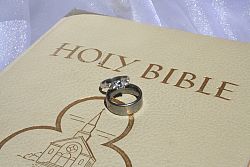Catholic weddings require preparation

SALT LAKE CITY — As with many celebrations, a Catholic wedding requires a lot of preparation, such as selecting the parish where the ceremony will be held, talking to the priest and taking the marriage preparation classes – not to mention selecting the bride’s dress and deciding the details of the reception. The policy of the Diocese of Salt Lake City suggests that a four-month notice be given to the parish selected for the marriage; parishioners need to contact the priest at their own parish of registry. The parish priests are responsible for the sacramental preparation. The couples need to belong to a parish to be married. There are also certain documents that must be obtained for marriage. Some of them will be completed through the parish priest. These documents include a pre-nuptial questionnaire, freedom affidavits and baptismal certificates that must be issued from the churches of baptism and dated within six months of the wedding. If a dispensation is needed, such as an annulment of a previous marriage, this process requires a minimum of nine months and can be facilitated by the parish priest. A marriage license must be obtained; this is a civil document, and must be obtained from the County Clerk within 30 days of the marriage. The Diocese of Salt Lake City also requires that the couples attend an Engaged Encounter weekend and the Natural Family Planning Class, both of which issue a certificate to be included with the documents submitted to the parish prior to the wedding. Among the different traditions that couples may celebrate during their Catholic wedding is one distinctly Hispanic tradition, the "padrinos" or godparents, who act as the couple’s mentors through the engagement and wedding, and often pay for specific parts of the ceremony. These sponsors are usually people who have played an important role in the lives of the bride and groom. Other common traditions associated with a Hispanic wedding ceremony are the 13 "arras," which are small coins, and "lazo" or lasso, which can also be a rosary, and a Bible. These traditions originate in Spain and often are a special part of the day. These represent elements of a marriage. While the Bible and Church wedding represent the spiritual element, the coins represent the physical element, with the number of coins said to represent Christ and his 12 disciples; the lasso represents the emotional element, symbolizing the unity, an extra-long strand of rosary beads (the "lazo"), which is usually placed in a figure eight shape around the necks of the couple after they exchange their vows to show the union and protection of marriage. "This act is symbolic of their love, which should bind the couple together every day, as they equally share the responsibility of marriage for the rest of their lives," said Father Rene Rodillas, administrator of Saint Olaf Parish. For more information about celebrating a Catholic wedding in the Diocese of Salt Lake City, go to your parish office or to www.dioslc.org.
© Copyright 2024 The Diocese of Salt Lake City. All rights reserved.

Stay Connected With Us